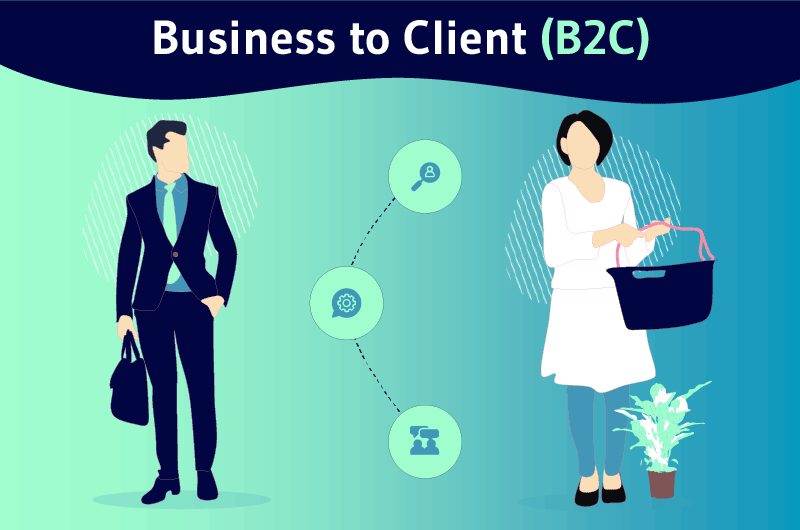The acronym B2C simply stands for Business-to-Consumer, which is a business model referring to the relationship between a company and end consumers. To be more precise, it is a system by which a manufacturer or seller sells products or services directly to the final consumer (who is an individual) without going through intermediaries.
Having a good understanding of the target market is essential for any company that wants to sell and succeed. While some companies choose to deal with other companies, the majority choose to do business directly with end consumers.
This is known as the B2C model, which is currently the most common business model.
So:
- BtoC, what exactly is it?
- What are the types of B2C models in the digital world?
- What is the difference between B2C and B2B?
- What is BtoC marketing?
- How does B2C marketing work?
- What are the marketing strategies to adopt to make a BtoC business work?
These are some of the questions I will explain in the rest of this mini-guide.
Let’s get started!
Chapter 1: What does B2C mean?
In this chapter, I will address all the questions that will allow you to have a clear and precise knowledge of the B2C concept
.1.1. B2C: What exactly is it?
While business-to-business refers to commercial transactions between companies, the business-to-consumer model refers to the sale of products or services to customers for personal use
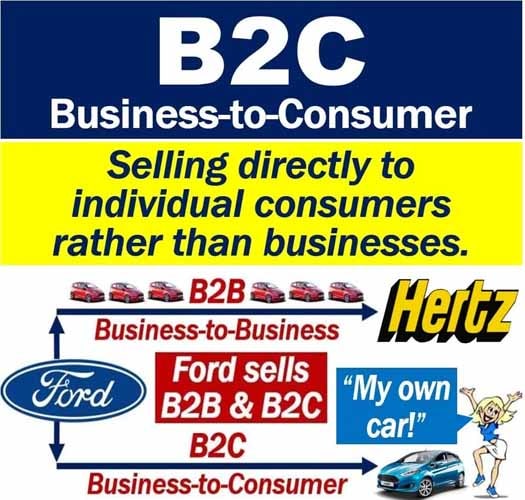
Often called B2C, this model allows businesses to connect, communicate and conduct business transactions with consumers most often via the Internet.
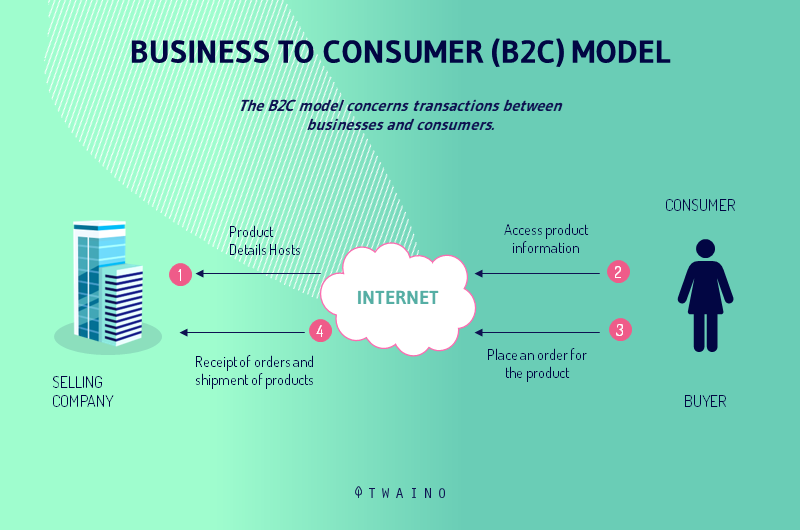
B2C is broader than just online retail, as it includes:
- Online banking
- Travel services;
- Online auctions
- Healthcare platforms;
- Etc.
Business to Consumer as a business model generally involves a higher volume of customers, but relatively lower revenue for the majority.
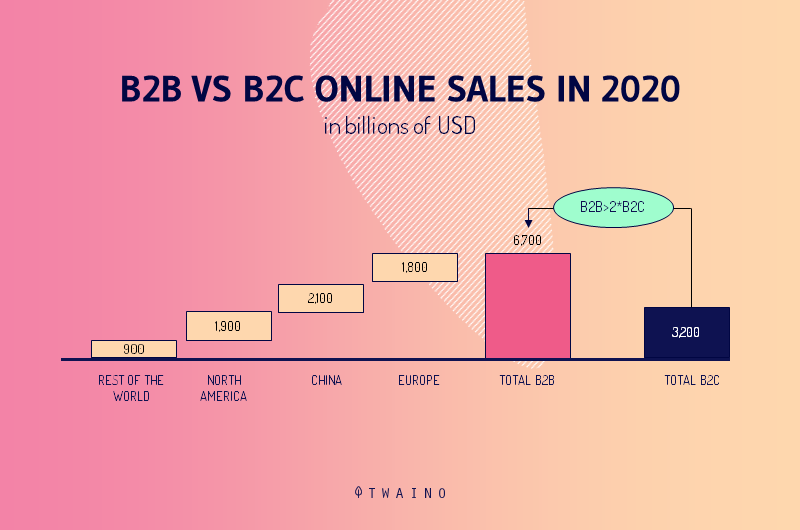
Some of the characteristics of this B2C business, in addition to those already mentioned, are:
- Simple and generally short buying process;
- Consumer purchase decision based on price, desire or status;
- The decision is made by an individual (influenced or not by others);
- Sales value is generally low compared to B2B.

Let’s look at some examples of B2C businesses to further our understanding.
Examples of B2C companies
Examples of B2C businesses are numerous and all around us. Some of them are:
- Retail businesses: Supermarkets, stores that sell products directly to the consumer, e-commerce sites, etc.
- Direct service businesses for individuals: Hairdressers, car garages, doctors’ offices, etc.
- Catering outlets: Restaurants and other places that sell meals.
Here are some of the BtoC companies that are leaders in the market today:
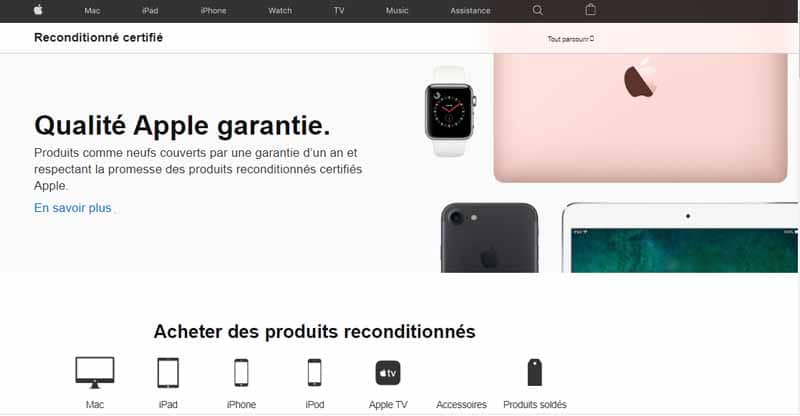
Apple designs and produces electronic hardware, software and online services. These range from smartphones (iPhones) to laptops (Macbooks) and desktops (iMac).
They are a great example of a B2C company as they design, develop, manufacture and sell electronic products to consumers.
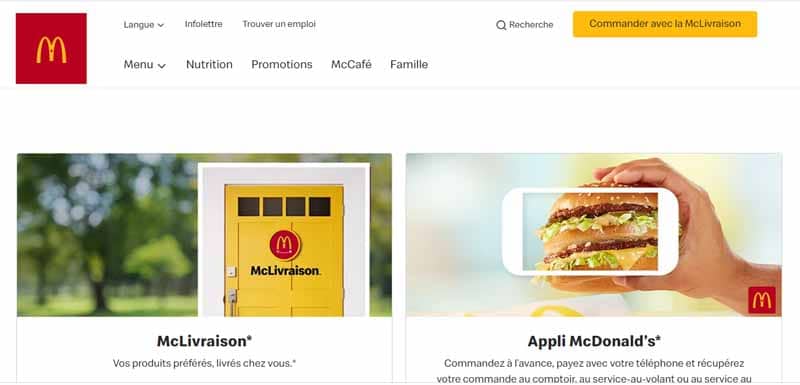
McDonald’s is an American fast food chain and has a great reputation because of its hamburgers. It represents a catering company for individuals and ranks among the largest companies in the world.
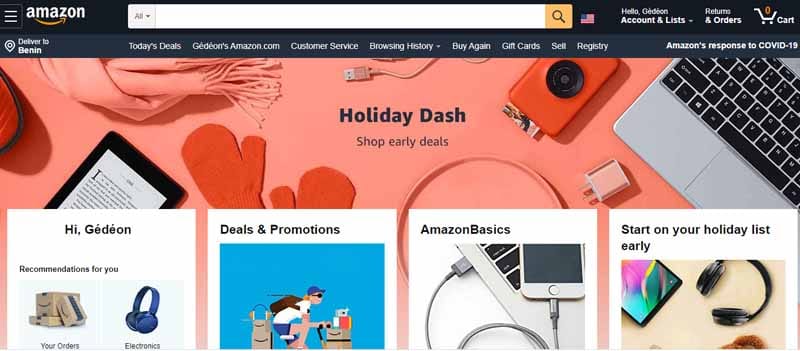
Amazon is the largest e-commerce site in the world. Amazon’s own products such as Amazon Prime and Amazon Originals (Amazon-funded media) are all excellent examples of its B2C nature.
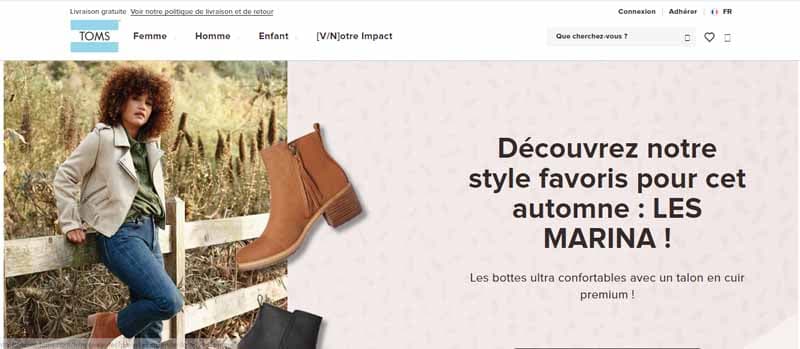
TOMS is a for-profit organization that designs and manufactures shoes, eyewear, and apparel. It is a company that creates and sells shoes and clothing to consumers via their physical and online storefronts.
1.2) How did B2C companies conquer the business market?
Thanks to the Internet, these B2B companies have given way to simpler BtoC systems, through which customers can buy directly from manufacturers
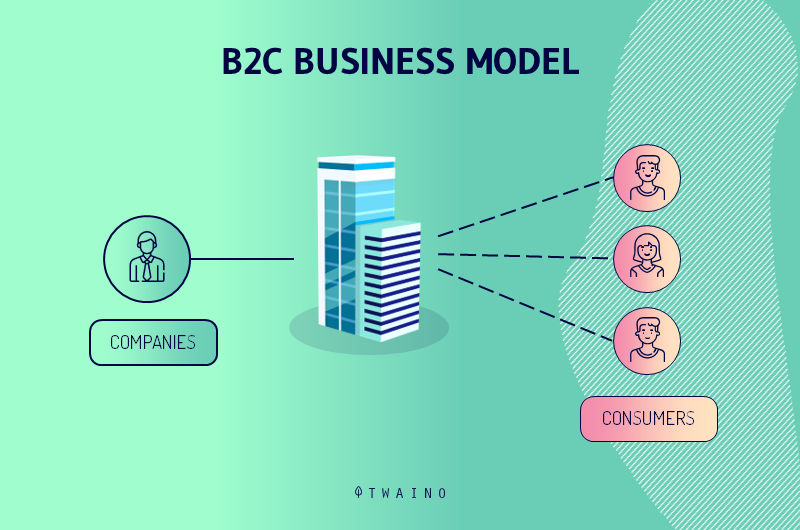
This financial streamlining has eliminated the middleman, making the BtoC model the modern standard.
As the initial growth of the Internet accelerated, more and more stores began to do business directly with consumers on their websites
In particular, sites like Amazon attracted a lot of traffic from physical stores. As a result, many physical retailers who lack digital savvy have been forced to close their doors
Although the BtoC model is the norm these days, the B2B model is still used
1.3. The different types of B2C models in the digital world
Business to consumer companies use five distinct models to move their products into a digital space:
- Direct sellers;
- Online intermediaries;
- Advertising models;
- Community models;
- Paid models
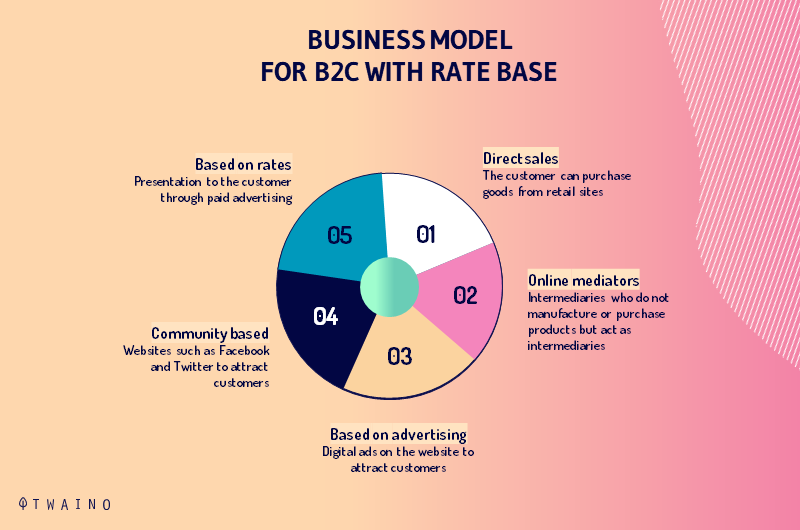
Let’s move on to the explanation of each of these models.
1.3.1. Direct sellers
This is the most popular type. Direct sellers, such as online retailers, sell a product or service directly to the consumer via a website.
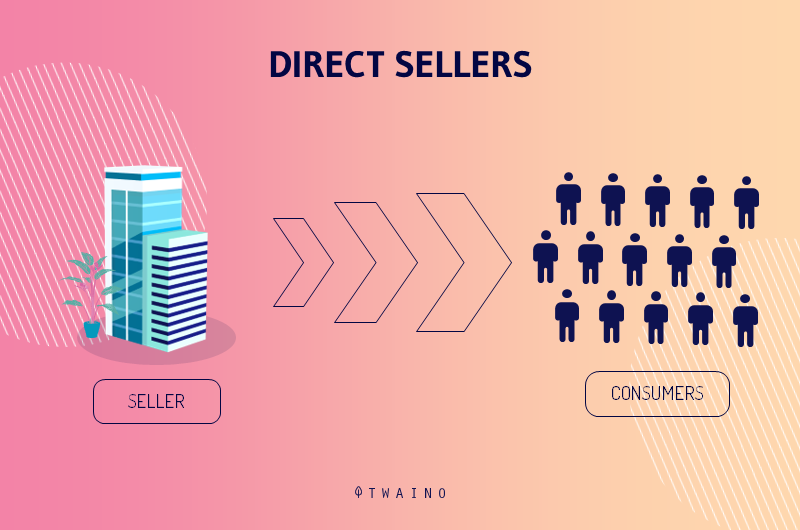
These direct sellers are further divided into two categories: The e-tailers and manufacturers
E-retailers are electronic retailers who ship products from their own warehouses or initiate deliveries from other companies.
Product manufacturers, on the other hand, use the Internet as a sales channel to eliminate the middleman. This includes large retailers such as Microsoft and Apple that sell products exclusively in-house to end consumers
1.3.2. Online intermediaries
These online intermediaries do not own the products sold on their site. Their primary role is to connect sellers and buyers directly
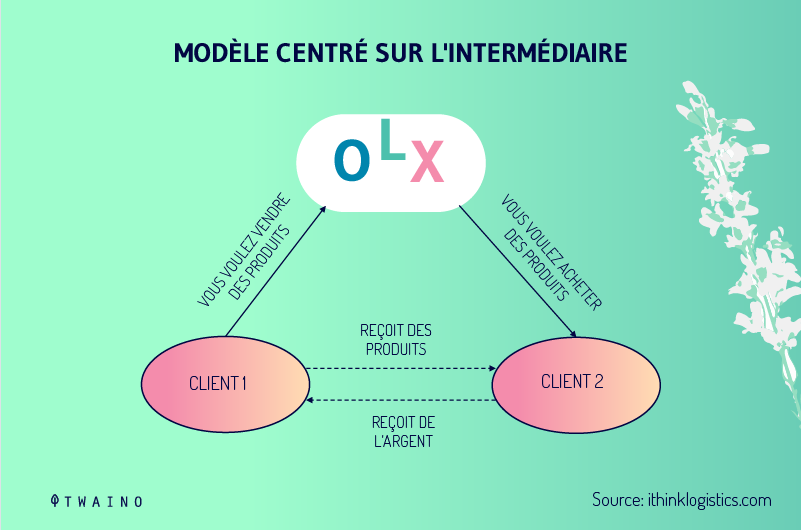
They usually profit by taking a commission on the price that the seller and the buyer finally agree on.
B2C e-commerce giants such as eBay, Amazon and Etsy are examples of online intermediaries.
1.3.3. The advertising-based B2C model
This is becoming more common as more and more people become exclusively interested in online media.
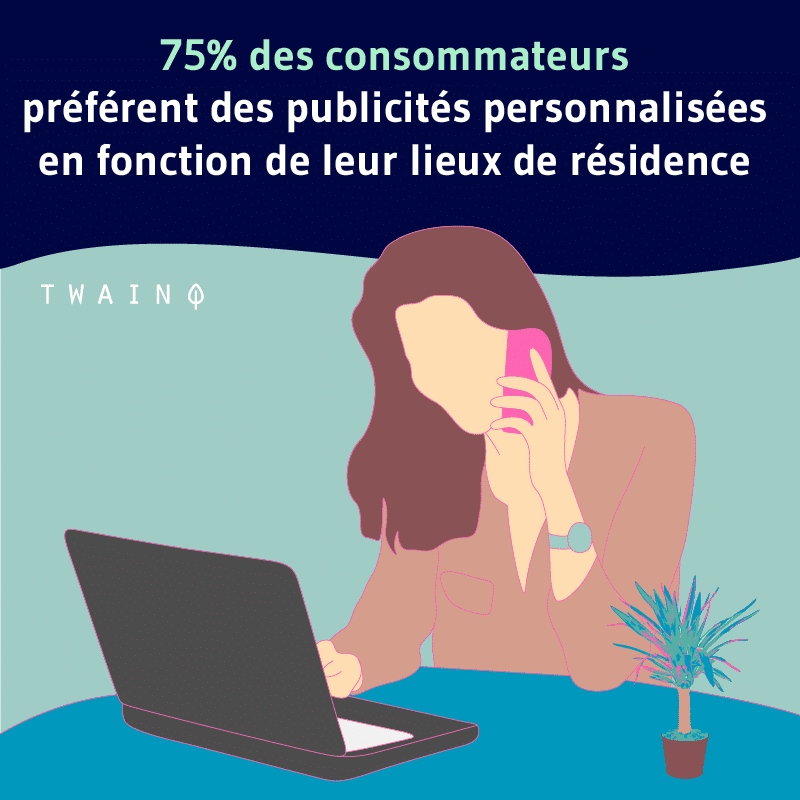
In this model, companies buy advertising space on platforms that receive large volumes of traffic, such as YouTube or Reddit
They then use that ad space to offer their products or services directly to consumers.
Targeted advertising uses criteria such as:
- Internet searches;
- Content viewed;
- Demographics to strategically place ads in front of promising customers
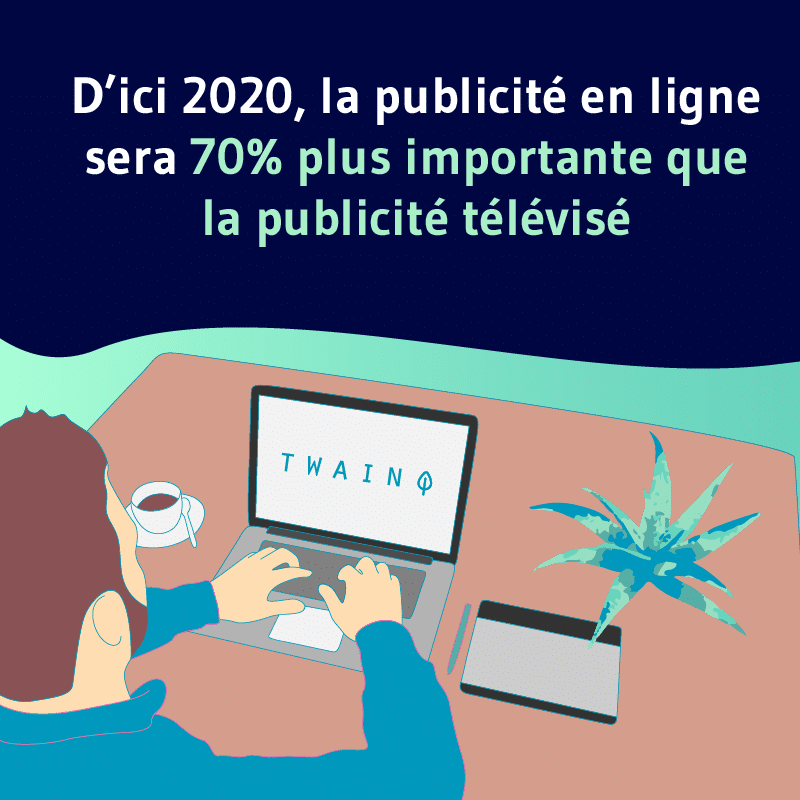
1.3.4. The B2C community model
This model uses like-minded online communities to allow advertisers to offer and sell their products directly.
Because many of these communities form around a common interest, companies can more easily identify promising leads.
For example, it might be an online forum for gardeners, pregnant women, or the over-sixties.
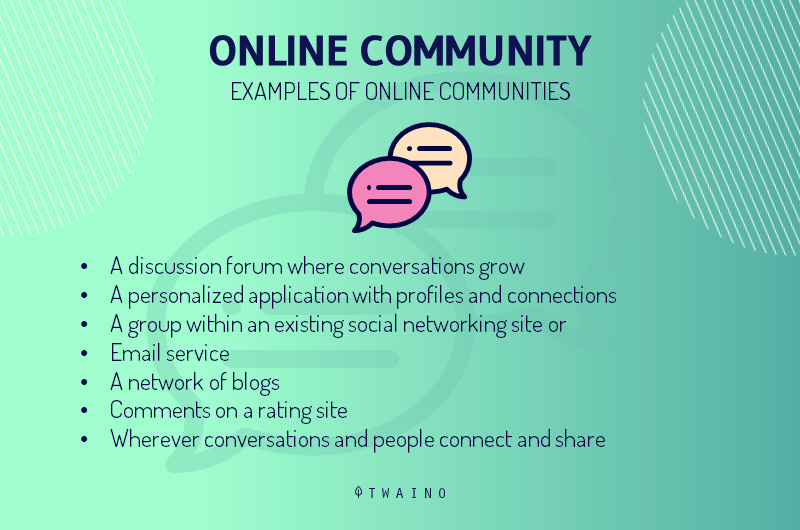
1.3.5. The B2C pay model
Payment or subscription services fall under this model. The most common are online subscription services such as NetFlix, Hulu, etc
These companies rely on the quality of their content to convince consumers to pay a fee that is mostly minimal.
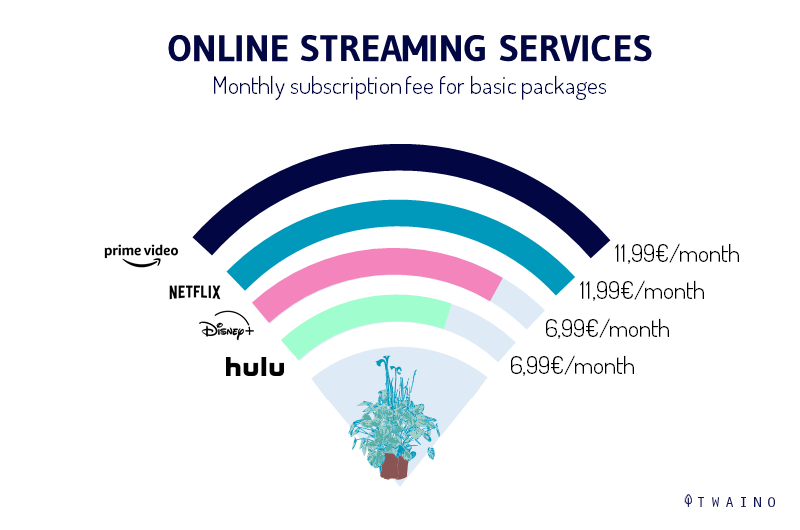
By selling directly to customers, manufacturers can avoid price markups on their products, especially in the digital realm
Some companies are also able to provide products or services at the customer’s request, which significantly reduces overhead costs
Websites can reach a much larger customer base than stores, which is crucial to the success of the BtoC model. For this reason, the B2C marketing world has become vital to the success of online businesses.
The lack of physical storefronts also negates the costs of ownership, keeping a company’s assets more liquid and greatly increasing the ease with which the business changes and grows
We can’t talk about the BtoC concept without comparing it to BtoB, which seems to be the closest model to it.
Chapter 2: B2C and B2B – Comparison
If B2C and B2B companies share some common points, they are still very different on several points.
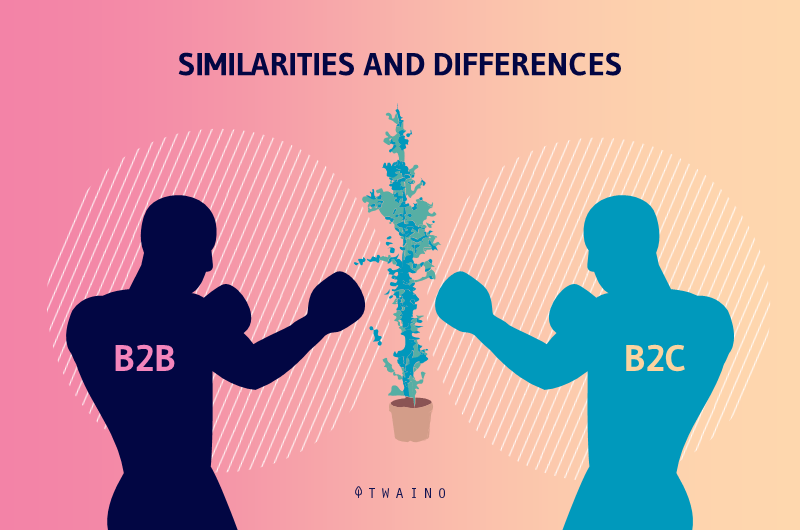
Let’s start by discussing the differences in these two business models.
2.1. What are the differences between B2C and B2B models?
B2C and B2B companies are different in several ways. We have
2.1.1. The objectives
B2C companies target a larger market and a group of end consumers. Unlike B2B, the targeting of the consumer group is unlimited
These business-to-consumer companies need to extend as widely as possible over the communication channels in order to attract the largest number of buyers.
In the B2B area, however, such a global positioning will not bring the required benefits. The objective in this area is to attract corporate customers via the target network.
2.1.2. The communication method
BtoC companies must adapt their communication methods to those of the end consumers according to their own knowledge
In other words, because of their lack of expertise, you need to avoid jargon and use easy-to-understand language.
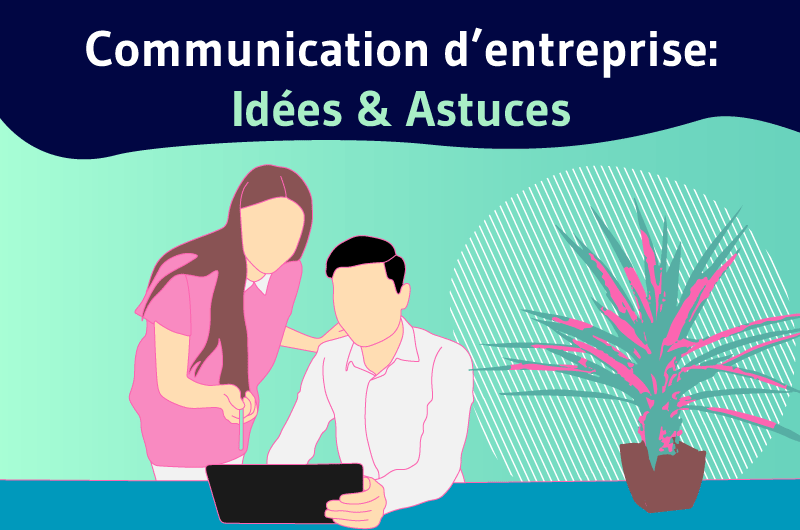
But as a B2B company, the language can be much more sustained. That said, the fundamentals don’t change and your content should always deliver information that is relevant to your targets.
2.1.3. The duration of the customer relationship
In the B2C model, building long-term relationships between seller and consumer is extremely rare, as purchases are often made without prior contact and without an ongoing relationship between the seller and the customer.
In addition, to make a purchase, these end consumers generally don’t need to investigate the selling company too much.

This is rarely true in B2B sales, where every action taken and every decision made is designed to build the trust necessary to establish a lasting business relationship between the two parties.
2.1.4. Products and services
Most of the time in the BtoC model, the products and services offered to the customer are created in series and are mainly intended for private use
In B2B, on the other hand, products or services are tailored to the individual needs of the customer. This leads to a high demand for suggestions and functional descriptions.
2.1.5. The price level
Generally, B2B sales require a lower price. This is due to the retail purchases of the end consumers

It is the opposite in B2B sales. Business customers are used to making bulk orders, which requires payment of a relatively high bottom.
2.1.6. The purchase decision
In B2C, the purchase decision is made by a single person, while in B2B, several company employees are usually involved in the purchase process, which complicates the process somewhat
In B2C, the emotional influence of the consumer is considered an important selling asset. In B2B, on the other hand, it is usually the data and facts about the product or service that matter.
For example: A consumer’s decision to buy a product in a market is mostly made on the spot. The likelihood that they will remember in a month is low. Meanwhile, B2B companies’ sales are planned and evaluated for the long term.
2.2. Summary of B2C vs. B2B characteristics
Here is a table that gives you an overview of the different characteristics of B2C and B2B markets:
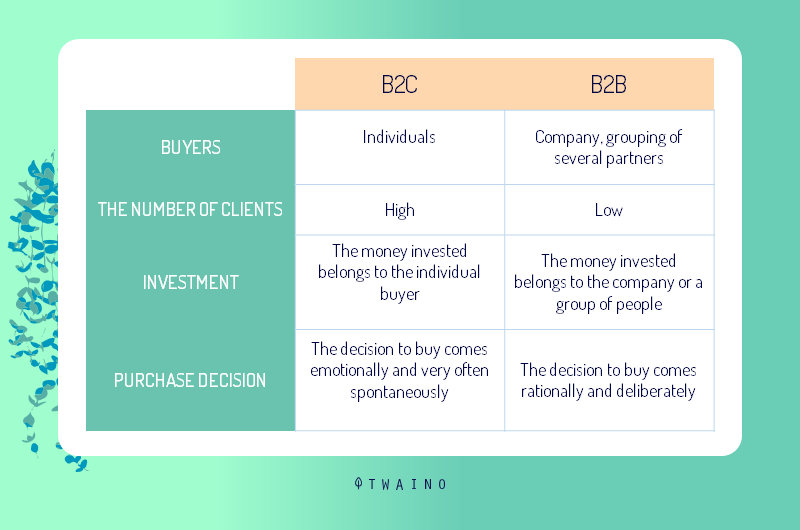
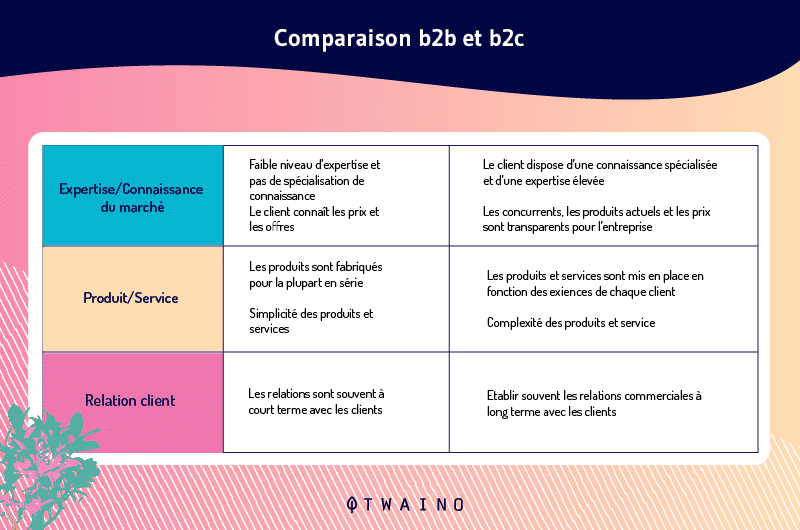
2.3. some similarities presented by the B2C and B2B models
Although the way of approaching customers in both models remains different, B2C and B2B also present similarities such as:
- A well-defined strategy
Lead generation in B2B sales may take more time and care, but without a clear strategy and established tactics, both approaches (B2C and B2B) risk failure and customer loss.
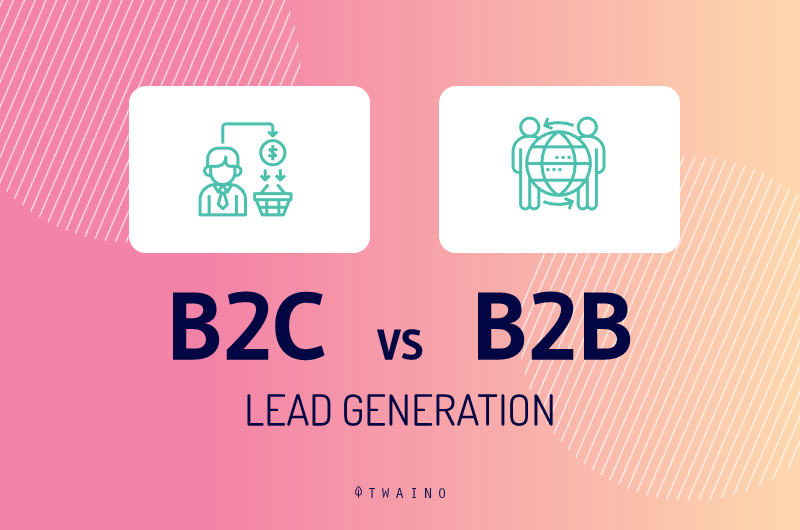
- Good marketing
If your online and offline marketing messages (for both models) don’t match up well with your business communications, potential customers (individuals or businesses) will be reluctant to deal with you.
- Excellent customer service
Once the sale is complete, the customer’s ability to contact your support team and get helpful services is linked to retention and churn rates. This applies to both B2C and B2B sales.
2.4. Transition between the two sales models
For salespeople, the transition between B2C and B2B sales (or vice versa) can be tricky.
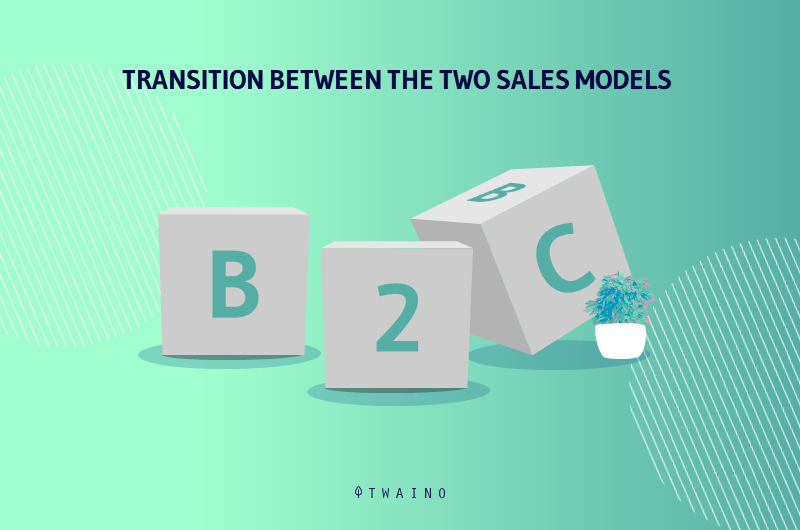
B2C sales professionals are used to a relatively short buying cycle and a somewhat broader connection to marketing and e-commerce.
The move to the B2B world would tend to frustrate most B2C salespeople because of the longer-term strategy and significant effort required to build relationships with enterprise customers.
On the other hand, the transition from a B2B to a retail (BtoC) environment may be too intense for the B2B sales professional, due to the wholesale and high-priced transactions they are already accustomed to.
Chapter 3: B2C Marketing: What is it all about?
In this chapter, I will discuss the concept of B2C marketing, how it works and some sample strategies to inspire you.
3.1. Definition
Business-to-consumer marketing is a form of marketing that helps companies communicate more effectively and persuasively with consumers. Television commercials for consumer products are an example of B2C marketing.
However, physical products are not the only potential products for B2C marketing. There are also information products.
Nevertheless, the communication techniques used for these products are not much different from those of a physical store owner.
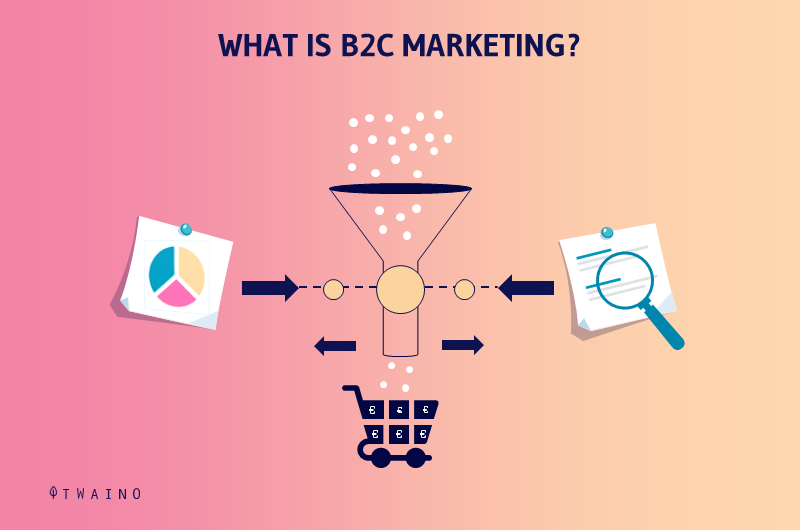
The main difference is that the communication will be done mainly online. This involves your ability to inform your potential customer about how your information product will improve their lives.
Information products provide personal benefits to each customer. Customers buy your products or services to:
- Solve a number of problems;
- Learn new skills in an area;
- Meet other needs.
This makes business-to-consumer marketing an extremely personal process. Whether online or offline, your goal is to build relationships with your potential customers so that they feel comfortable buying from you, not just once, but again and again.
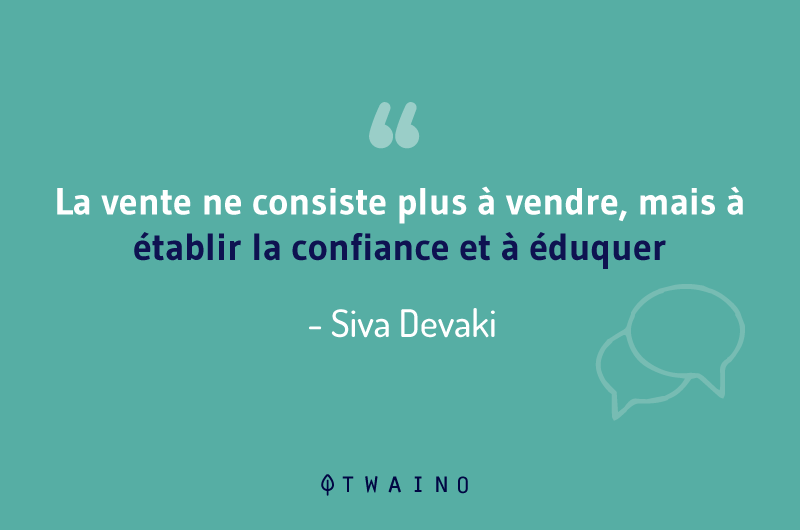
Good BtoC marketing can speed up and improve the customer acquisition process, but also build loyalty. The better your marketing gets, the more you will sell your products or services.
3.2. B2C marketing: How does it work?
Of course you can’t embark on a marketing strategy without fully understanding how exactly it works
All B2C marketing campaigns are based on one goal: Convince a consumer to buy products and keep them loyal forever
However, many variables come into play before the final transaction actually occurs.
For example, let’s say you sell online cooking courses. It will be less complicated to influence your target market (cooks) if your marketing material takes into account the following elements
- The essential practices of a good cook;
- The best tips for good cooking;
- Information about the mistakes that most cooks make;
- Promises related to the release of new recipes;
- Etc.
In other words, you have to determine the customer’s needs and how to present the product to satisfy them.
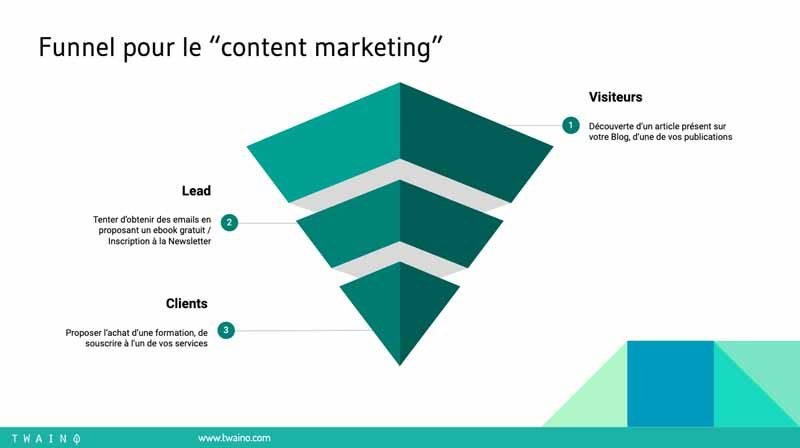
The principle of operation of B2C marketing goes through the following three steps:
- Introduce your business to consumers;
- Encourage consumers to interact with your brand;
- Getting them to make a purchase
To succeed in BtoC marketing, certain strategies must be put in place.
3.3. Some examples of B2C marketing strategies to inspire you
BtoC marketing strategies help you to:
- Prepare for sales
- Anticipate responses;
- Track progress
These three factors can make your marketing campaigns more successful.
Poor marketing can have a negative impact on your business and its reputation for years to come. That’s why it’s advisable to leverage as many B2C marketing strategies as possible
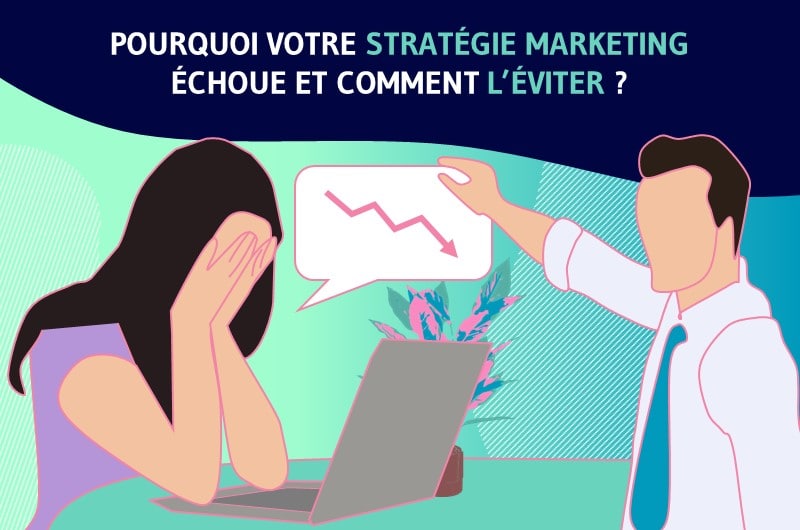
Also remember that some marketing strategies are better suited for one business than another. Just because another entrepreneur has had great success with a particular strategy doesn’t mean it will work for you as well.
Always test everything. That’s the only way to know which B2C marketing strategies will yield a positive response from your target audience.
Let’s take a look at 10 of the most effective BtoC marketing strategies
3.3.1. Connect with prospects on a human level in your content creation
Let’s start with content marketing. If you’re focused on building relationships with your prospects, you need to treat them like human beings, not ATMs, who will pull out money for your products.
Whether you post on blogs or social media, creating authentic content for your brand is paramount
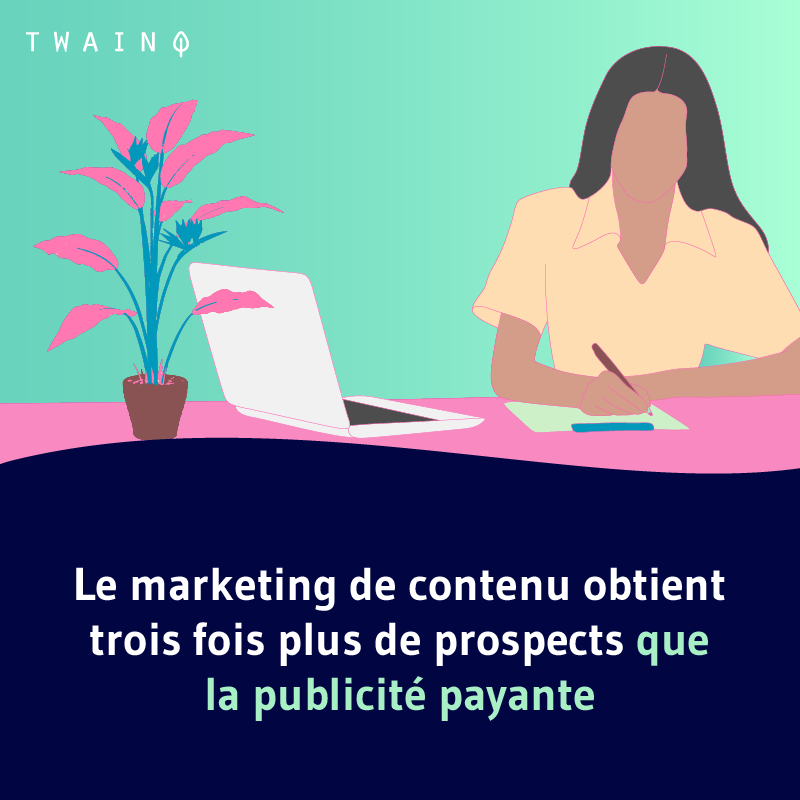
Connect with users on a human level by sharing your own story with them to help them understand their frustrations.
The idea here is to present yourself and your company as a solution to the problems your customers are personally experiencing.
3.3.2. The email marketing strategy
Sending regular newsletters to customers allows B2C businesses to establish a strong and direct connection with them. This marketing strategy also allows BtoC businesses to attract new customers and sell products or services more easily.
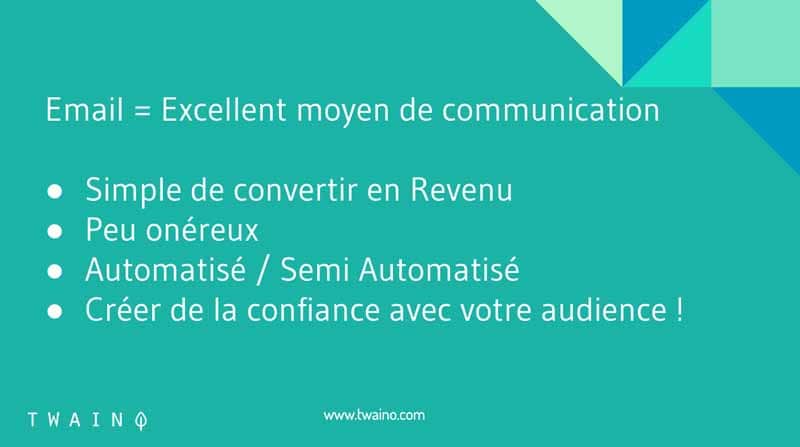
To get the emails of prospects, you need to personalize your newsletter by offering them a special gift.
There are many reasons why consumers subscribe to a newsletter. Some customers subscribe just to be entertained or informed. Others, however, pay special attention to educational information and new offers
As mentioned above, emotion is usually the key to successful communication with B2B customers. They need to be challenged, feel chosen and able to identify with your brand.
3.3.3. Organize creative and attractive contests
Everyone loves a contest. The idea of winning something for free is almost too appealing to pass up.
You can run a contest on your site, on social media, or other places you see fit. Many entrepreneurs use webinars to run contests
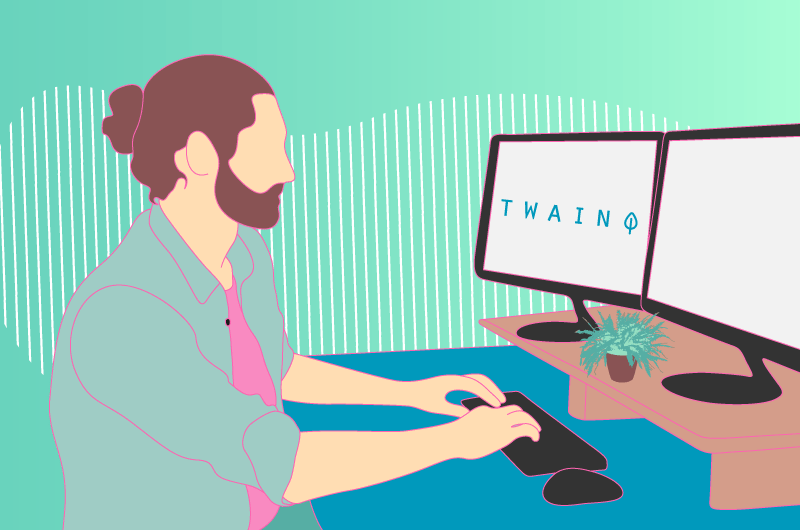
These contests increase your webinar entries and help you gain visibility at the same time. During contests, it is also important to give away something that your target audience will find valuable.
Some professionals may be tempted to give away something expensive to winning prospects that has nothing to do with their business
Sure, many people would love a new flat screen TV, but if your niche has nothing to do with TV, the contest won’t have the desired outcome. So it’s obvious to choose a gift that relates to what you do.
3.3.4. Add a free offer with every purchase
A free offer with every purchase adds even more value to the product you are selling. In other words, it lets people know they’re getting something extra without needing to shell out more money.
It’s a win for both parties: You get paid for your product and the customer gets a bonus gift in return
The choice of the free offer depends on what you want to offer. It can be a mini-course related to your core business. It can also be an e-book or a binder that will help your customers to better use your online courses.
3.3.5. Prioritize searcher intent for SEO
Many entrepreneurs fail to consider searcher intent when optimizing their content for SEO. For example, some assume that all Google searches are the same, which is not the case
The searcher intent refers to the reason why the searcher performs a Google search
For example, if a user living in Paris wants to eat something, he may search on Google for “restaurants in Paris“. If he is interested in cooking, he might search for ” parisian recipes for beginners “.
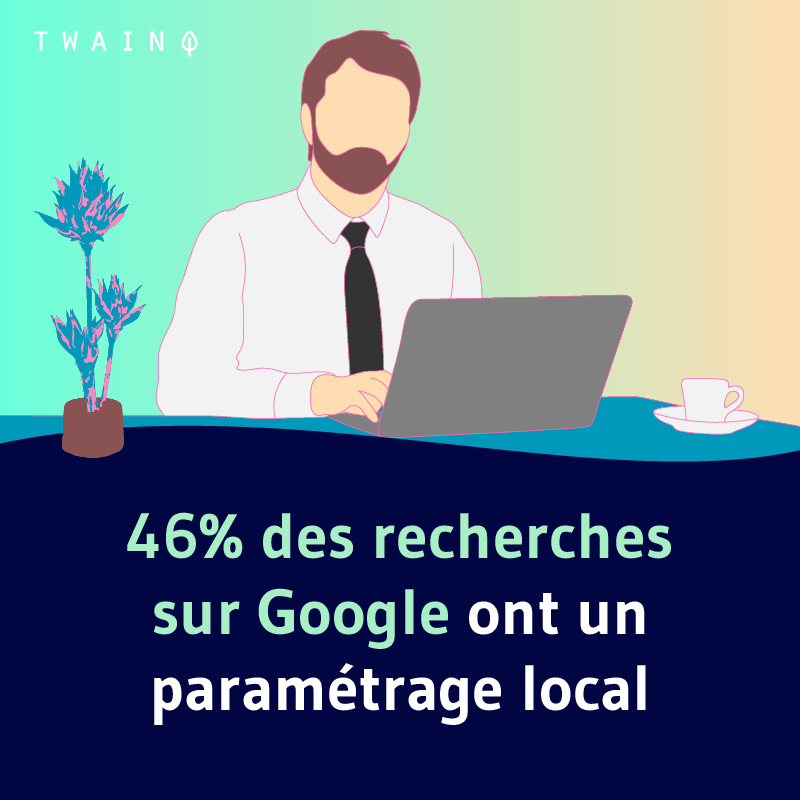
The search type indicates the intention. After the search, consumers perform actions such as:
- Gathering information;
- Comparing options
- Making a purchase
Therefore, you need to pay special attention to the consumer’s intent when creating your content.
3.3.6. Run ad retargeting programs
Ad retargeting sounds like a difficult concept, but it’s actually quite simple. It involves reconnecting with consumers who have connected with your business in the past. It’s especially relevant for B2C marketing.
As a form of paid advertising, retargeting can put a strain on your budget. However, if you use it correctly, the return on investment can be worth it.
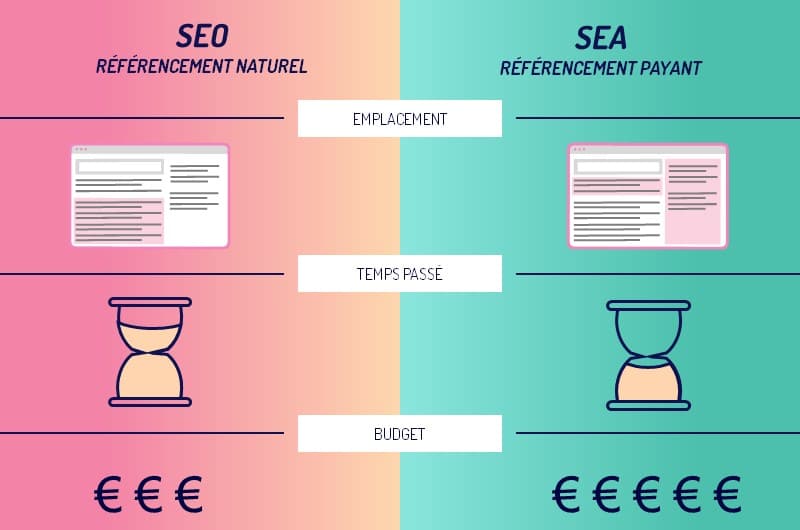
When a consumer first comes in contact with your business, a sequence is triggered. The next time the customer visits Facebook, for example, they will see an ad for your business.
That customer may not immediately click on the ad or buy from you. However, seeing the ad again reinforces your brand and helps the consumer remember your business in the future.
3.3.7. Create membership programs
Also known as a loyalty program, a membership program combines competitiveness and rewards. It encourages consumers to interact with your business to increase their membership levels.
As consumers progress through the membership levels, they will have access to more rewards, which enhances their relationship with your company.
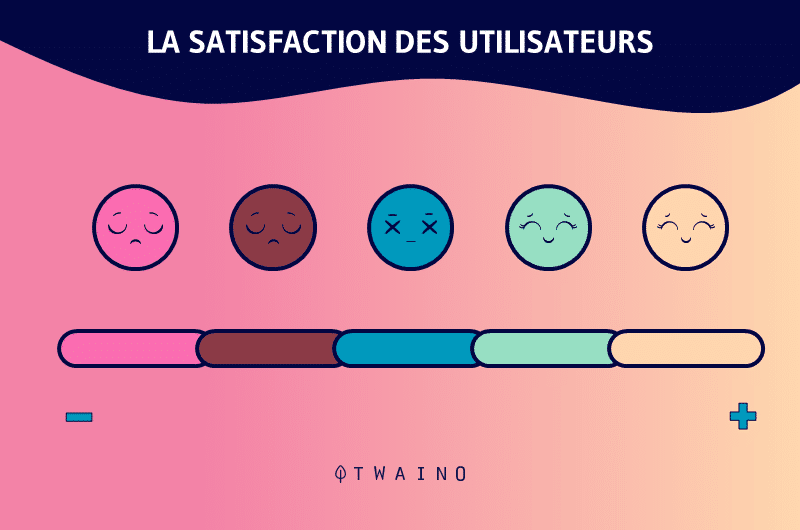
Here is an example of three membership levels you can create for your business:
- Bronze: Bronze level customers receive free discounts on your digital products every quarter.
- Silver: Those who reach the silver level receive a special downloadable asset twice a year in addition to discounts.
- Gold: At the highest level, consumers receive bronze and silver rewards as well as a free 15-minute phone consultation each year.
Of course, you can name the levels whatever you want and choose the rewards as you see fit
3.3.8. Use social media
Many brands have achieved incredible success using social networks. Some of them invest in paid advertising, while others take an organic approach.
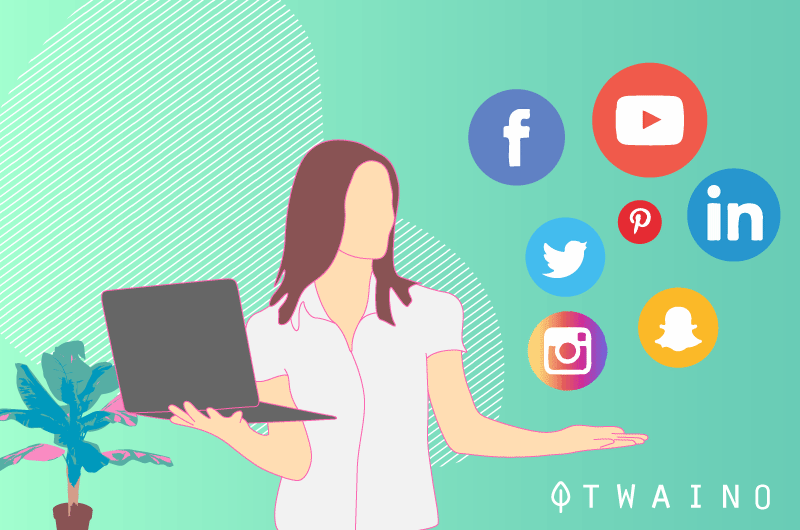
If you don’t have enough budget to invest in social advertising, focus on building your audience through strategic B2C marketing
There are many strategies to consider to get users to engage organically with your brand on social networks.
3.3.9. Build relationships with micro-influencers
Micro-influencers are social media personalities in a very specific niche. They are often followed by a small but loyal community that usually makes buying decisions based on the opinions of these influencers.

Partnering with these micro-influencers to promote your product or service can be a boon for your business. Nevertheless, make sure you choose an influencer who specializes in the same niche as you
This promotion may require paying a price. Nevertheless, it is definitely worth it, as the return on investment is quite considerable when the choice of influencer is well made.
3.3.10. Invest in mobile marketing first
The world is moving in a mobile-oriented direction
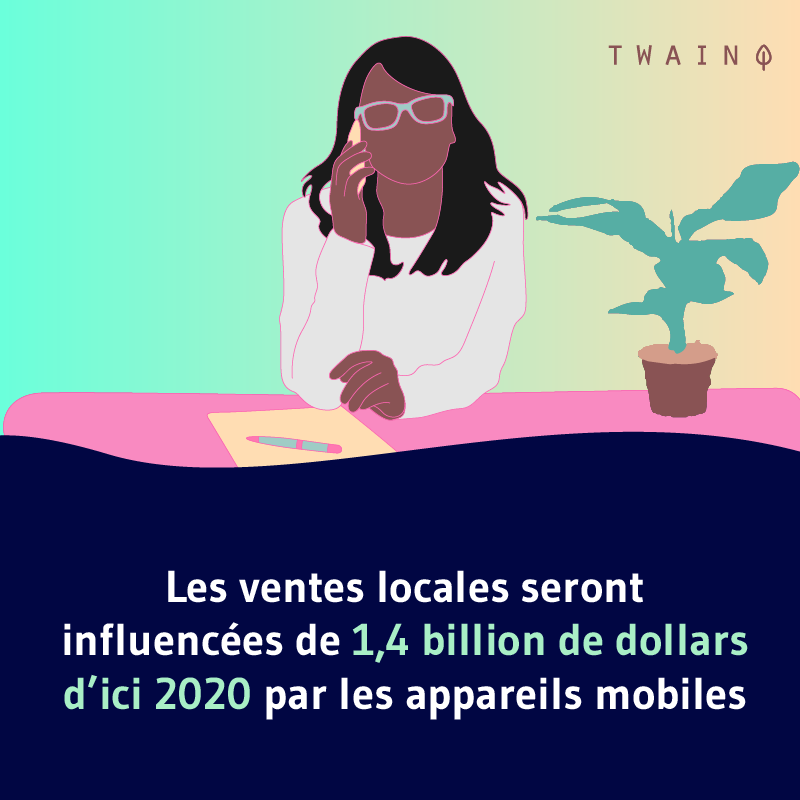
Many users no longer own laptops or desktops. They rely on tablets, phones and even watches to perform all their computing tasks.
That’s why it’s essential for B2C marketers to adopt a mobile-focused strategy. Determine how your content will best appeal to your audience on mobile devices.
This starts with a responsive website. If you create your website with a properly responsive theme, you will automatically have a responsive layout that will look great on all devices
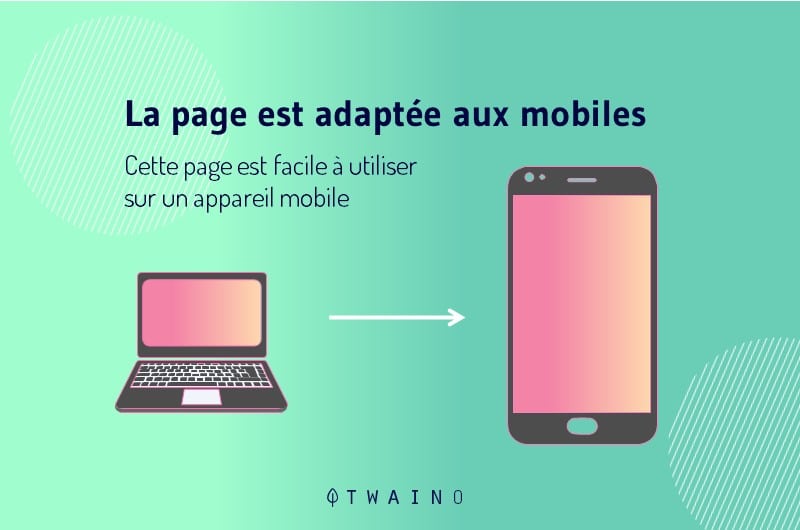
Also, if you want your posts to look great on mobile, from your blog to your social networks, be sure to check out this article.
In summary
B2C is a fairly simple model. If a business is directly addressing end consumers (or for personal use), then it is part of the BtoC market.
By now, I hope you have a better understanding of the BtoC concept, the best marketing strategies to adopt in this area and how to avoid confusing it with the B2B model.
You now have all the information you need to launch a brand in this market. I hope this article will help you and bring all the solutions to your problems
See you soon!

